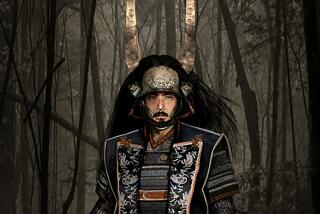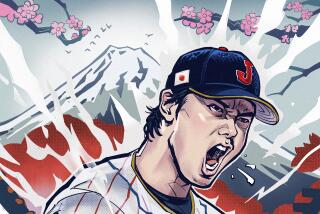‘Beast’ Examines Japan’s Culture
- Share via
The art of every civilization is a mixture of tradition, observation and imagination. Maybe that’s why a special exhibition at the Pacific Asia Museum is, initially, a little puzzling.
Titled “The Nature of the Beast,” about 50 drawings, scrolls and screens set out to show us how traditional Japanese art depicts animals.
Earlier Japanese artists copied Chinese art. They were less interested in what animals really looked like than what they symbolized. The point is illustrated in a section called “Drawing From Tradition.” It includes Nanko Sogan’s “Boy and Ox,” an image a 15th century Buddhist audience would have immediately understood as standing for the difficulties of attaining enlightenment when the seeker is as naive as a child and his soul as stubborn as a beast. If the drawing was a little stiff, it wasn’t deemed to matter.
A section labeled “Drawing From Reality” intends to demonstrate how Japanese artists of the 18th and 19th centuries increasingly derived their imagery from models. Katsushika Hokusai’s “Eagle in a Snowstorm” has remarkable verisimilitude, but it’s clear that the combination of bird, blizzard and drawing makes it very unlikely the scene was actually rendered from life.
Among works representing imagination, the only obviously invented animal is the dragon. The only clearly trumped-up scenes are humorous situations like a wrestling match for frogs. Aside from that, Nagasawa Rosetu’s ferociously friendly tiger looks like the real thing. So does a big feline by Hokusai, even though it’s a safe bet the artist never saw one.
What all this intends to teach, I think, is that art succeeds not by separating convention, reality and imagination, but by mixing them. To nail down the point, we’re treated to a related solo exhibition of some of Hokusai’s paintings, prints and drawings.
If any artist in either exhibition qualifies as a household name in the West, it’s Hokusai (1760-1849). One of the few Japanese artists to qualify as an Occidental-style bohemian genius, he’s said to have lived in more than 100 houses and changed his name some 30 times. Brash as an American Pop artist, he’s best known for such frankly commercial print series as “The 36 Views of Mt. Fuji.”
Three on display remind us of how good they are. But his hands-on drawings turn tradition into emotion, imagination into cosmic humor and both of them into a reality that erases the border between Asian and European art.
Two drawings depict courtesans lounging in outdoor pavilions rendered with a tenderness worthy of Rembrandt. Casual reputation notwithstanding, Hokusai retains that flinty Japanese technical control that miniaturizes the world in perfect scale, imbuing each line with structural purpose and impeccable decorative elan.
Late works are so startlingly modern in their expressive frankness we think of Picasso. “Two Wrestlers Locked in Combat” has an almost erotic energy. “Praying Goblin in Rondel” shows a dotty old elf that is surely the artist. In his last letter to a friend, Hokusai wrote that he was planning to “rent a studio at the corner of Hell street” and paint pictures for “the King of the InfernalRegions.”
*
“Paintings, Prints and Drawings by Hokusai” to Sept. 2, “The Nature of the Beast,” to Sept. 30, Pacific Asia Museum, 46 N. Los Robles Ave., Pasadena. Closed Mondays and Tuesdays. (818) 449-2742.
More to Read
The biggest entertainment stories
Get our big stories about Hollywood, film, television, music, arts, culture and more right in your inbox as soon as they publish.
You may occasionally receive promotional content from the Los Angeles Times.










